Divide between bright and dark HDR TV display technology
Starting in 2016, it seems that all non-Internet brands in the TV industry are speaking a single word, HDR. Following the blazing new technology in recent years, such as 3D, 4K, curved surfaces, quantum dots, and OLEDs, HDR will become a must-see highland for display technology in 2016, and each has completed its corresponding product layout.

Although HDR is a phrase that has long been spoken for many years in the photographic circle, the concept of HDR TV can be considered to have taken shape in 2016. So, what is the display principle of this thing called HDR? What are the technical characteristics? In the technical descriptions of TV brands that I have come into contact with today, Sony is one of the few brands that can systematically promote the use of HDR technology.
1. The significance of HDR: In order to expand the contrast between bright and dark parts of the image and the details of the image
Popular HDR is definitely the most mature field in which the application is known. I first started accessing HDR technology through photography. HDR is an abbreviation of high dynamic range image, in which the dynamic range refers to the range of brightness and contrast and the high dynamic range has a wider range of brightness and darkness and higher light and dark contrast. It is to expand the contrast between bright and dark areas of the image. And image details. The text expression is a bit harsh, we see this:
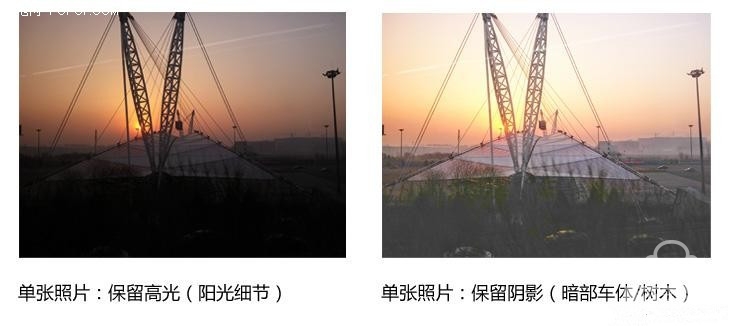 Here are two early morning sunrise scenes shot on the subway using a mobile phone. When shooting, I focus on different areas of metering. According to the camera's photometry program, it has two choices to help me keep the details of the "bright" or "dark" part of the picture, so the figure I get is that the sun's outline is very clear, and the light is too uniform, but The foreground is dark; while Figure 2 basically does not show the shape of the sun, the sky is also lost in the early morning glow, but the outline of the foreground body is more obvious. Both of these image styles are normal images of the phone under different metering conditions, but they are all very different from what the naked eye sees.
Here are two early morning sunrise scenes shot on the subway using a mobile phone. When shooting, I focus on different areas of metering. According to the camera's photometry program, it has two choices to help me keep the details of the "bright" or "dark" part of the picture, so the figure I get is that the sun's outline is very clear, and the light is too uniform, but The foreground is dark; while Figure 2 basically does not show the shape of the sun, the sky is also lost in the early morning glow, but the outline of the foreground body is more obvious. Both of these image styles are normal images of the phone under different metering conditions, but they are all very different from what the naked eye sees.
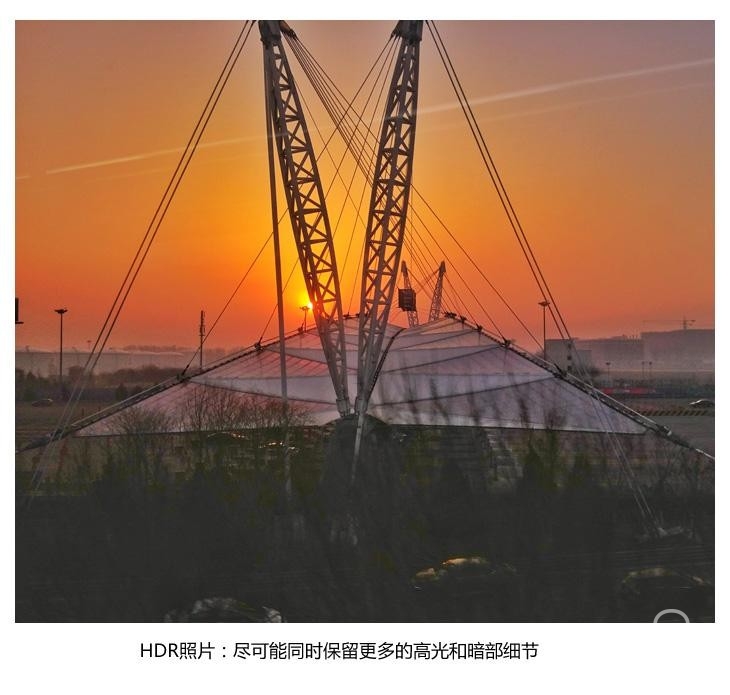
In a 24-bit JPG image captured on a cell phone or camera, the compressed image format does not have more space to retain more color and "brightness" information, so the "brightness" in the face of such bright and dim light is very different. In the scene, the single-exposed image can only retain the high-luminance area details or the dark part as much as possible, and can not retain the details of the highlight and the dark part of the image at the same time, that is, it can not restore the true contrast between the eyes and the eyes. HDR technology It is to restore more details of light and dark parts of the image.
2. HDR Realization: TV backlight control, signal processing, film source are indispensable
In the above example, the principle and meaning of the HDR technology under the static image application is explained. The HDR-processed photo can be equal to the slice source we usually refer to. For the TV system, it is to solve the problem of how to restore the wide dynamic range of the HDR source.

In the real world, objects that can reflect light to the human eye will exhibit color and brightness. For example, it shows the brightness values ​​of different objects in bright and dark environments. The highest brightness divided by the lowest brightness is the picture below. The maximum contrast, it also corresponds to the dynamic range of this scene. For television, the current state-of-the-art is unable to restore the actual light and shadow contrast scenes viewed by the human eye. This is related to the limitations of television's own display technology. At the same time, video (film source) shooting and transmission also restrict TV to light and dark light. Than the expression.
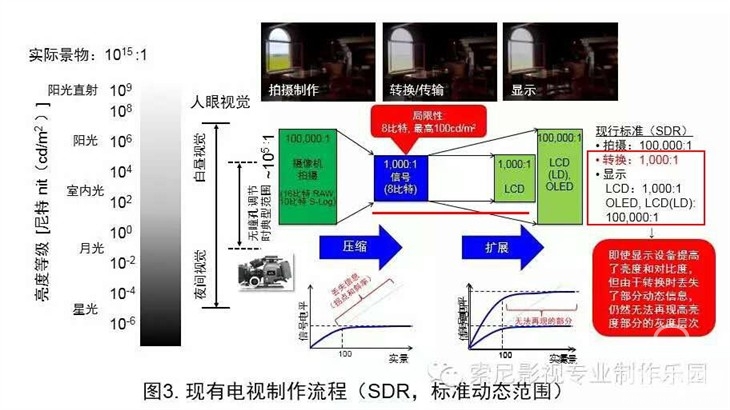

So far, most of the film and video sources we have contacted are based on the "Standard Dynamic Range (SDR)". Note that we are not referring to shooting. Before the advent of HDR TV and film formats, digital video cameras could already produce dynamic ranges that were much higher than TV's ability to reproduce. However, in order to take care of the technical display on the display side, the video content to be shot needs to be “compressed†and the video signal output to the TV is compressed from a relatively high dynamic range to a standard dynamic range. Because HDR technology TVs have improved their signal processing and backlighting technologies, they have the hardware power to express HDR film sources. Therefore, the high dynamic range signals in the shooting stage can be input to the TV in an approximately uncompressed form. At this point, the video is completed. Full HDR expression for shooting, transmission to TV decoding, and output screen.
3, HDR technology is NB? The texture of light and shadow is obviously enhanced, but only when the HDR source is released can the effect be seen.
Speaking half a day of technical principles, how good is HDR TV? Let's take a look at the picture differences between SDR and HDR signals on normal and HDR television.
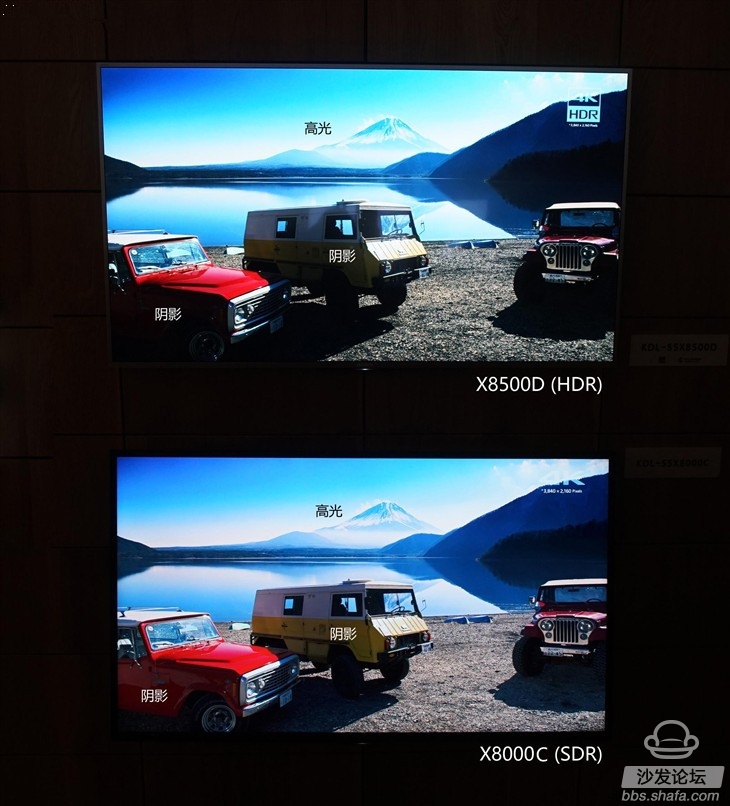
In the picture above, the two TVs are Sony's 4K Ultra HDTVs. The top is Sony's new 16-year X8500D TV, and the lower is the non-HDR 15-year TV X8000C. When we see the contrast image, let's not be busy trying to find out what everyone thinks. Think about what the light and shadow of this scene should look like: The calm lake reflects the sunny mountain scenery, the sun is at 2 o'clock diagonally, far away from the mountain. The side of the backlight is smooth, as is the car in the foreground.
What is the effect of performance on two televisions? At first glance, the overall highlights of the two TVs are in place, but there is no apparent brightness overflow. The white snow and vegetation at the distant peaks still retain details. The sky is not overexposed to death. But what about the shadow? The most obvious difference is in the two cars in the foreground on the left. The HDR TV above shows smooth light and backlight shadows, while the brightness of the yellow truck's backlight in the TV below has not been effectively suppressed. The front yellow hood area and The contrast of the body brightness in the body side shadow is not obvious. In addition, the hood and side of the red car front can also show the "unnatural" expression of the dark part.
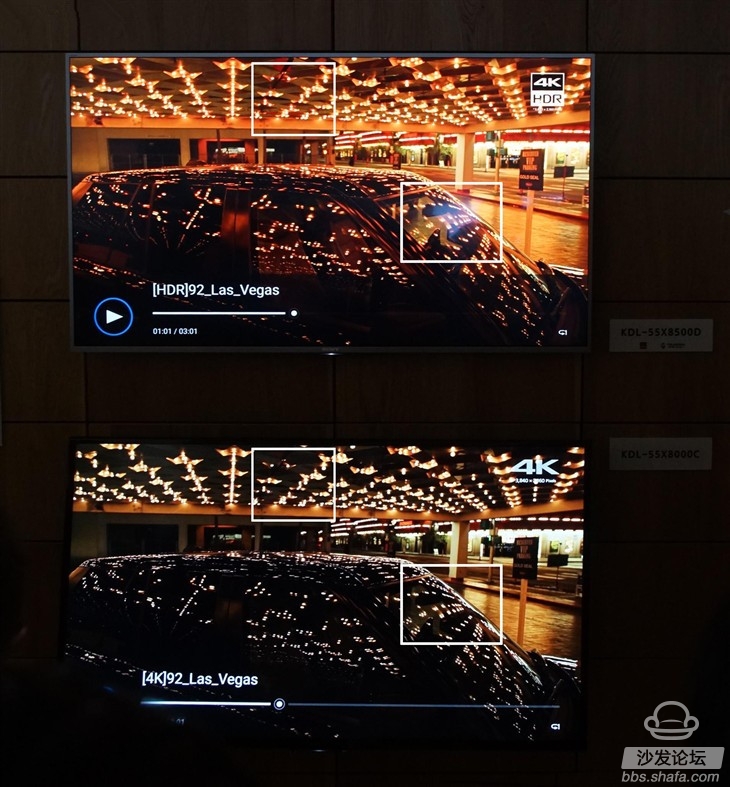
The contrast of this night scene is mainly in the high light part. The most obvious contrast between the two TV sets is that the overall brightness of the HDR technology is stronger, which includes higher brightness lights, light-shaded ground and cars. The HDR TV can show the light and shadow details of the ground lighting through the window, while the SDR TV underneath took care of the dark expression of the dark field, lowering the overall brightness of the screen, and the lighting is not so attractive. The body is smooth and The metal texture is also hidden.
4, HDD TV in the end do you want to start?
After watching HDR's good, let's throw some cold water again. Do you still remember the prerequisite for comparison? “The picture difference between SDR and HDR signals on ordinary and HDR TVs†means that there are two prerequisites for enjoying the HDR effect. TV can support HDR technology and HDR source. Similar to the current situation of 4K video, there are not many movies on the market currently supporting HDR technology. This year's news is still saying that certain publishers will launch HDR version of the movie in 2016, and certain video sites will begin to support HDR. Technology, etc. As of now, HDR technology is only at the initial stage in the film industry.
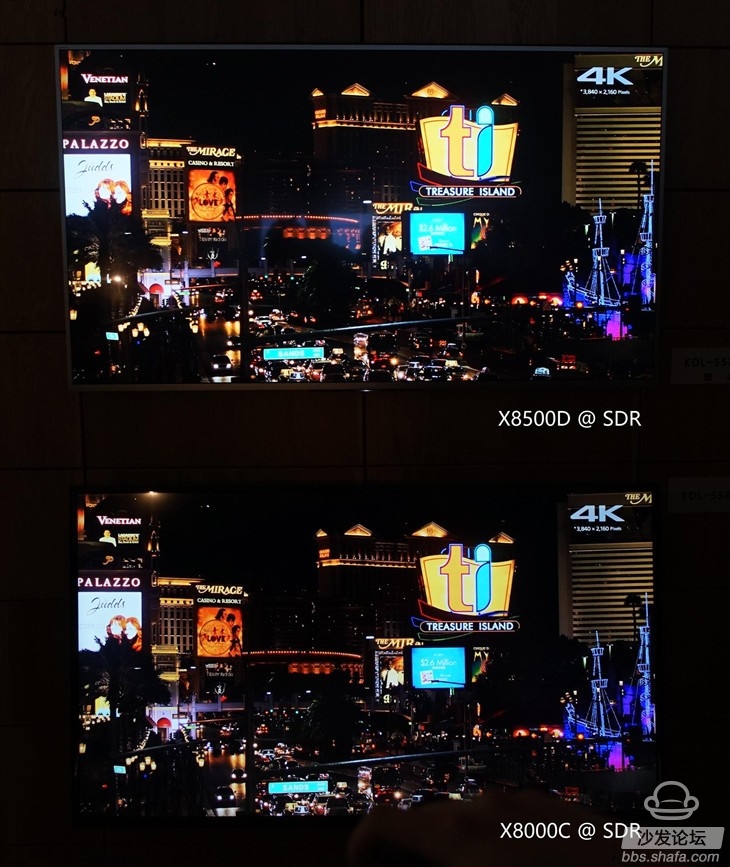
In another case, when you buy an HDR TV but do not have HDR content, will this TV be better than normal TV? The answer may be yes, because HDR TVs require more sophisticated backlight control capabilities. However, the effect of HDR TV on playing SDR content is very limited. The content that is compressed when the video is encoded cannot be restored through the quality processing of the TV. The difference is more like non-HDR era high-definition television. The difference in quality TV is mainly due to the difference in backlight design and has nothing to do with HDR technology.
Sony 55X8500D 4K HDR TV, Gome Online, 8999 yuan Click to buy
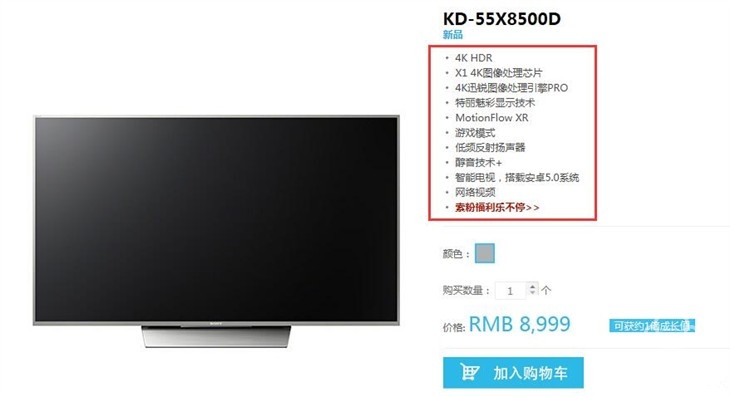
In the end, you may still have a question that has not been answered and say so many HDR TVs. It is worth buying. On this topic, let's take a look at Sony's specific products for the past two years. The first is the most basic 4K TV, X8000C, this TV is only supported by Sony's basic 4K Sharp PRO and MotionFlow XR dynamic optimization technology. After the evolution to the X8500D, the original plastic shell was replaced with an exquisite body with a metal frame, and the body posture was thinner than the previous generation of TV. The technical level was the latest HDR technology and Terricolor charm support. Comprehensive increase in the above configuration, the official price of the two is only the difference between 7499 and 8999 yuan, this 1500 yuan is actually not too difficult to put Sony 4K TV as the target user group, I personally think that the difference in performance in exchange for performance is still a matter Value for money, not to mention HDR is likely to become the standard technology for making movies in the next year or two. â–

Although HDR is a phrase that has long been spoken for many years in the photographic circle, the concept of HDR TV can be considered to have taken shape in 2016. So, what is the display principle of this thing called HDR? What are the technical characteristics? In the technical descriptions of TV brands that I have come into contact with today, Sony is one of the few brands that can systematically promote the use of HDR technology.
1. The significance of HDR: In order to expand the contrast between bright and dark parts of the image and the details of the image
Popular HDR is definitely the most mature field in which the application is known. I first started accessing HDR technology through photography. HDR is an abbreviation of high dynamic range image, in which the dynamic range refers to the range of brightness and contrast and the high dynamic range has a wider range of brightness and darkness and higher light and dark contrast. It is to expand the contrast between bright and dark areas of the image. And image details. The text expression is a bit harsh, we see this:


After HDR processing, the brightness and color information of the sky is retained maximally, while the dark details have been restored to a large extent
In a 24-bit JPG image captured on a cell phone or camera, the compressed image format does not have more space to retain more color and "brightness" information, so the "brightness" in the face of such bright and dim light is very different. In the scene, the single-exposed image can only retain the high-luminance area details or the dark part as much as possible, and can not retain the details of the highlight and the dark part of the image at the same time, that is, it can not restore the true contrast between the eyes and the eyes. HDR technology It is to restore more details of light and dark parts of the image.
2. HDR Realization: TV backlight control, signal processing, film source are indispensable
In the above example, the principle and meaning of the HDR technology under the static image application is explained. The HDR-processed photo can be equal to the slice source we usually refer to. For the TV system, it is to solve the problem of how to restore the wide dynamic range of the HDR source.

Typical brightness and darkness of different objects in the scene
In the real world, objects that can reflect light to the human eye will exhibit color and brightness. For example, it shows the brightness values ​​of different objects in bright and dark environments. The highest brightness divided by the lowest brightness is the picture below. The maximum contrast, it also corresponds to the dynamic range of this scene. For television, the current state-of-the-art is unable to restore the actual light and shadow contrast scenes viewed by the human eye. This is related to the limitations of television's own display technology. At the same time, video (film source) shooting and transmission also restrict TV to light and dark light. Than the expression.

Even SDR can achieve a high dynamic range of 100,000:1 during early shooting. However, in signal transmission, the dynamic range is compressed to 1000:1 in order to take care of the contrast performance of the display device.

HDR video signal transmission and terminal display devices can achieve a high dynamic range of 100000:1
So far, most of the film and video sources we have contacted are based on the "Standard Dynamic Range (SDR)". Note that we are not referring to shooting. Before the advent of HDR TV and film formats, digital video cameras could already produce dynamic ranges that were much higher than TV's ability to reproduce. However, in order to take care of the technical display on the display side, the video content to be shot needs to be “compressed†and the video signal output to the TV is compressed from a relatively high dynamic range to a standard dynamic range. Because HDR technology TVs have improved their signal processing and backlighting technologies, they have the hardware power to express HDR film sources. Therefore, the high dynamic range signals in the shooting stage can be input to the TV in an approximately uncompressed form. At this point, the video is completed. Full HDR expression for shooting, transmission to TV decoding, and output screen.
3, HDR technology is NB? The texture of light and shadow is obviously enhanced, but only when the HDR source is released can the effect be seen.
Speaking half a day of technical principles, how good is HDR TV? Let's take a look at the picture differences between SDR and HDR signals on normal and HDR television.

In the picture above, the two TVs are Sony's 4K Ultra HDTVs. The top is Sony's new 16-year X8500D TV, and the lower is the non-HDR 15-year TV X8000C. When we see the contrast image, let's not be busy trying to find out what everyone thinks. Think about what the light and shadow of this scene should look like: The calm lake reflects the sunny mountain scenery, the sun is at 2 o'clock diagonally, far away from the mountain. The side of the backlight is smooth, as is the car in the foreground.
What is the effect of performance on two televisions? At first glance, the overall highlights of the two TVs are in place, but there is no apparent brightness overflow. The white snow and vegetation at the distant peaks still retain details. The sky is not overexposed to death. But what about the shadow? The most obvious difference is in the two cars in the foreground on the left. The HDR TV above shows smooth light and backlight shadows, while the brightness of the yellow truck's backlight in the TV below has not been effectively suppressed. The front yellow hood area and The contrast of the body brightness in the body side shadow is not obvious. In addition, the hood and side of the red car front can also show the "unnatural" expression of the dark part.

The contrast of this night scene is mainly in the high light part. The most obvious contrast between the two TV sets is that the overall brightness of the HDR technology is stronger, which includes higher brightness lights, light-shaded ground and cars. The HDR TV can show the light and shadow details of the ground lighting through the window, while the SDR TV underneath took care of the dark expression of the dark field, lowering the overall brightness of the screen, and the lighting is not so attractive. The body is smooth and The metal texture is also hidden.
4, HDD TV in the end do you want to start?
After watching HDR's good, let's throw some cold water again. Do you still remember the prerequisite for comparison? “The picture difference between SDR and HDR signals on ordinary and HDR TVs†means that there are two prerequisites for enjoying the HDR effect. TV can support HDR technology and HDR source. Similar to the current situation of 4K video, there are not many movies on the market currently supporting HDR technology. This year's news is still saying that certain publishers will launch HDR version of the movie in 2016, and certain video sites will begin to support HDR. Technology, etc. As of now, HDR technology is only at the initial stage in the film industry.

In another case, when you buy an HDR TV but do not have HDR content, will this TV be better than normal TV? The answer may be yes, because HDR TVs require more sophisticated backlight control capabilities. However, the effect of HDR TV on playing SDR content is very limited. The content that is compressed when the video is encoded cannot be restored through the quality processing of the TV. The difference is more like non-HDR era high-definition television. The difference in quality TV is mainly due to the difference in backlight design and has nothing to do with HDR technology.
Sony 55X8500D 4K HDR TV, Gome Online, 8999 yuan Click to buy

Sony X8500D (16 New Products)
In the end, you may still have a question that has not been answered and say so many HDR TVs. It is worth buying. On this topic, let's take a look at Sony's specific products for the past two years. The first is the most basic 4K TV, X8000C, this TV is only supported by Sony's basic 4K Sharp PRO and MotionFlow XR dynamic optimization technology. After the evolution to the X8500D, the original plastic shell was replaced with an exquisite body with a metal frame, and the body posture was thinner than the previous generation of TV. The technical level was the latest HDR technology and Terricolor charm support. Comprehensive increase in the above configuration, the official price of the two is only the difference between 7499 and 8999 yuan, this 1500 yuan is actually not too difficult to put Sony 4K TV as the target user group, I personally think that the difference in performance in exchange for performance is still a matter Value for money, not to mention HDR is likely to become the standard technology for making movies in the next year or two. â–
Fenghua Jade Motor Co., Ltd. , http://www.nscircuitbreaker.com